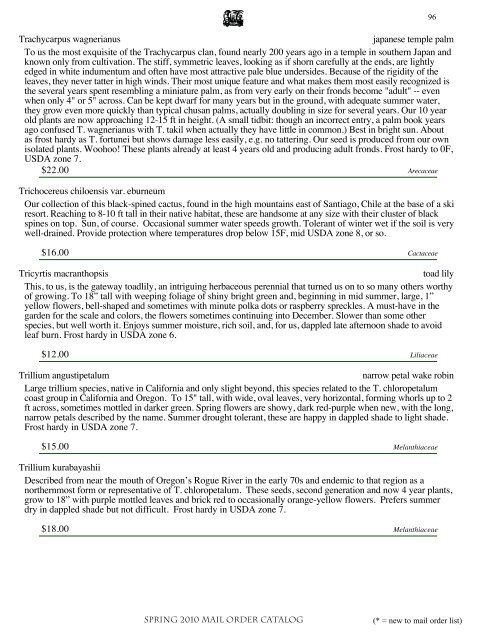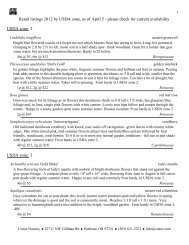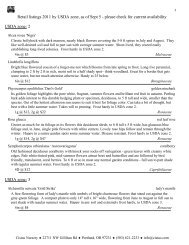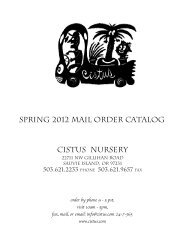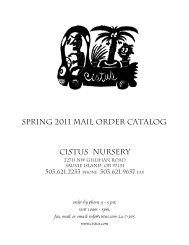Mail Order Catalog Fall 2010 - Cistus Nursery
Mail Order Catalog Fall 2010 - Cistus Nursery
Mail Order Catalog Fall 2010 - Cistus Nursery
Create successful ePaper yourself
Turn your PDF publications into a flip-book with our unique Google optimized e-Paper software.
Trachycarpus wagnerianus japanese temple palm<br />
To us the most exquisite of the Trachycarpus clan, found nearly 200 years ago in a temple in southern Japan and<br />
known only from cultivation. The stiff, symmetric leaves, looking as if shorn carefully at the ends, are lightly<br />
edged in white indumentum and often have most attractive pale blue undersides. Because of the rigidity of the<br />
leaves, they never tatter in high winds. Their most unique feature and what makes them most easily recognized is<br />
the several years spent resembling a miniature palm, as from very early on their fronds become "adult" -- even<br />
when only 4" or 5" across. Can be kept dwarf for many years but in the ground, with adequate summer water,<br />
they grow even more quickly than typical chusan palms, actually doubling in size for several years. Our 10 year<br />
old plants are now approaching 12-15 ft in height. (A small tidbit: though an incorrect entry, a palm book years<br />
ago confused T. wagnerianus with T. takil when actually they have little in common.) Best in bright sun. About<br />
as frost hardy as T. fortunei but shows damage less easily, e.g. no tattering. Our seed is produced from our own<br />
isolated plants. Woohoo! These plants already at least 4 years old and producing adult fronds. Frost hardy to 0F,<br />
USDA zone 7.<br />
$22.00<br />
Arecaceae<br />
Trichocereus chiloensis var. eburneum<br />
Our collection of this black-spined cactus, found in the high mountains east of Santiago, Chile at the base of a ski<br />
resort. Reaching to 8-10 ft tall in their native habitat, these are handsome at any size with their cluster of black<br />
spines on top. Sun, of course. Occasional summer water speeds growth. Tolerant of winter wet if the soil is very<br />
well-drained. Provide protection where temperatures drop below 15F, mid USDA zone 8, or so.<br />
$16.00<br />
96<br />
Cactaceae<br />
Tricyrtis macranthopsis toad lily<br />
This, to us, is the gateway toadlily, an intriguing herbaceous perennial that turned us on to so many others worthy<br />
of growing. To 18” tall with weeping foliage of shiny bright green and, beginning in mid summer, large, 1”<br />
yellow flowers, bell-shaped and sometimes with minute polka dots or raspberry spreckles. A must-have in the<br />
garden for the scale and colors, the flowers sometimes continuing into December. Slower than some other<br />
species, but well worth it. Enjoys summer moisture, rich soil, and, for us, dappled late afternoon shade to avoid<br />
leaf burn. Frost hardy in USDA zone 6.<br />
$12.00<br />
Liliaceae<br />
Trillium angustipetalum narrow petal wake robin<br />
Large trillium species, native in California and only slight beyond, this species related to the T. chloropetalum<br />
coast group in California and Oregon. To 15" tall, with wide, oval leaves, very horizontal, forming whorls up to 2<br />
ft across, sometimes mottled in darker green. Spring flowers are showy, dark red-purple when new, with the long,<br />
narrow petals described by the name. Summer drought tolerant, these are happy in dappled shade to light shade.<br />
Frost hardy in USDA zone 7.<br />
$15.00<br />
Melanthiaceae<br />
Trillium kurabayashii<br />
Described from near the mouth of Oregon’s Rogue River in the early 70s and endemic to that region as a<br />
northernmost form or representative of T. chloropetalum. These seeds, second generation and now 4 year plants,<br />
grow to 18” with purple mottled leaves and brick red to occasionally orange-yellow flowers. Prefers summer<br />
dry in dappled shade but not difficult. Frost hardy in USDA zone 7.<br />
$18.00<br />
Melanthiaceae<br />
Spring <strong>2010</strong> <strong>Mail</strong> <strong>Order</strong> <strong>Catalog</strong> (* = new to mail order list)


